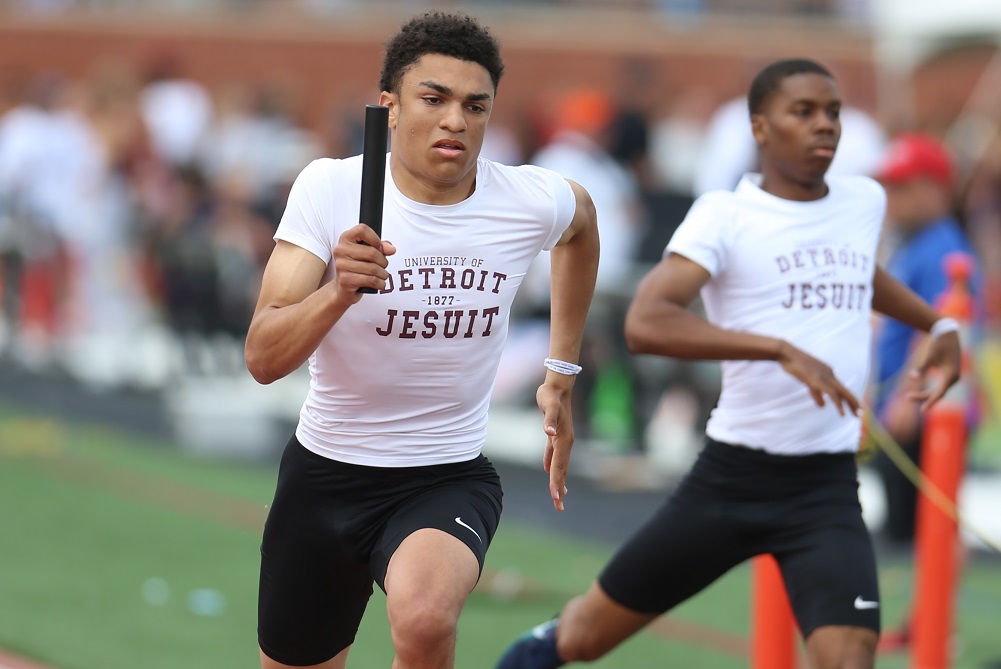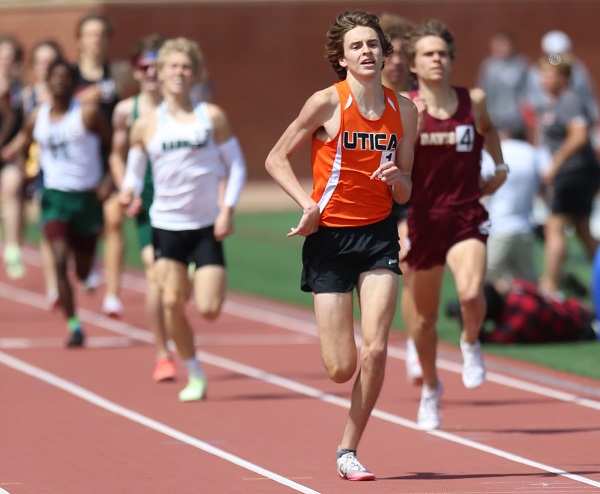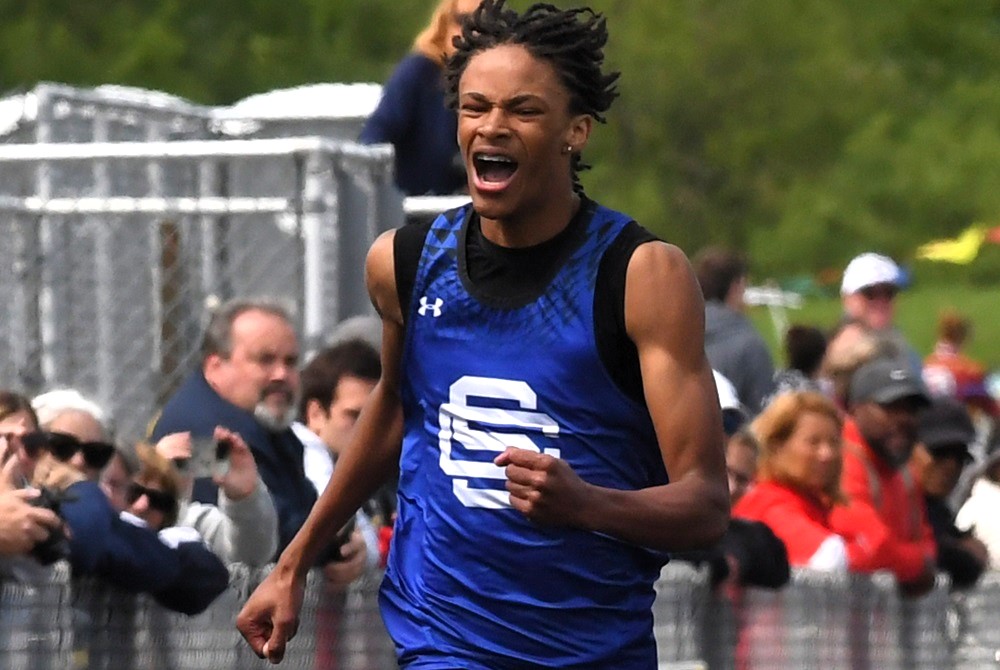
Jesuit Emerges from Meet Full of Close Finishes with 1st Team Title Since 1993
By
Paul Costanzo
Special for MHSAA.com
June 4, 2022
ROCKFORD – Jaiden Reed had faith in the Detroit U-D Jesuit 1,600-meter relay team.
Despite the fact the Cubs qualified into the slowest of the three race heats out of the Regional, Reed knew Cameron Hendrix, Bryson Wade, Nick Johnson and Devin Grantham would come through.
His faith was rewarded.
The foursome finished the first heat with a time of 3 minutes, 21.67 seconds, a time that held up enough through two more heats to clinch the Lower Peninsula Division 1 Finals title.
“I’m excited – my emotions are everywhere right now,” Reed said. “I was looking, and it was a one-point lead from what we were looking at. It’s just a lot of emotions. My heart was racing. It stopped, it was skipping beats. But I knew they were going to do it. I knew they were going to pull through. Even without our original four, I still knew they were going to do what they had to do.”
Thanks in part to that third-place 1,600 relay, U-D Jesuit finished with 41 points, 10 ahead of second-place Farmington.
The Cubs thought they had a one-point win, as East Kentwood’s 1,600 relay team was the initial winner, which would have made the top two scores U-D Jesuit 40, East Kentwood 39. But the Falcons were disqualified from the race, and finished tied for third with Clinton Township Chippewa Valley at 29. Rochester Adams rounded out the top five with 24 points.
It was the second team Finals title for the Cubs, with their last coming in Class B in 1993.
“They started talking about it in the winter, ‘What’s the goal? It’s a state title,’” U-D Jesuit coach Carl Brock said. “So to be able to manifest it, it’s something special for them. State meets, everything has to go well and you have to have some luck, and that happened today. For Jaiden to not win the 100 or the 200 (he finished second and fourth, respectively) and us still win the team title, something had to break in our favor, and it did.”
The Cubs did not have an individual champion, but won both the 400 and 800 relays. Reed was joined by Johnson, Grantham and Hendrix on both relays, which won in 42.39 and 1:28.06. The 1,600 relay team finished third after the East Kentwood DQ.
“Watching them develop their brotherhood,” Brock said. “Watching them come together as family. Some of these kids have traveled all over the country running with one another. They’ve stayed in hotel rooms together, they’ve developed that brotherly bond. They’re running for each other, and that’s what it’s all about.”
The only athlete to win multiple individual titles Saturday was Clinton Township Chippewa Valley’s Shamar Heard, who claimed both sprint crowns. He won the 100 in 10.77 and the 200 in 21.32.
 There were plenty of surprises on the day, though, and plenty of tight finishes.
There were plenty of surprises on the day, though, and plenty of tight finishes.
One even needed a camera review, as East Kentwood freshman Malachi Mosley eked out a victory over Oak Park’s Josh Flake in the 400. Each runner finished with an official time of 48.85, but Mosley was four thousandths of a second better.
“I just went out there and had to run my race,” Mosley said. “I was supposed to be in Lane 7, they moved me to Lane 2, and I was just really surprised. When I realized I could have a chance to catch those top people, I just pulled ahead. I tried to push myself harder than I ever have, and it worked. I was able to catch him.”
The 800 featured another tight, exciting finish, as Utica’s Trent McFarland used a final kick to pass Davison’s Brady McAardle in the final 20 meters, and win in 1:52.03. That race got an unexpected early spark when Saline’s Jason Whitton put up a 1:54.81 in the first heat, a time that only McArdle had bested during the season. He ended up finishing sixth.
“A kick is all heart, it’s all effort,” McFarland said. “Usually I’m known for giving my all at the end. The race went just to plan, I did it perfectly, paced it perfectly. I knew I had to take off that last 300 meters. I saw I was in position for the win in the last 100 meters and I just went. (Whitton) definitely added a little bit of pressure. But me and the other top runners in the group, we talked, we knew what we were going to do. We all wanted to go 1:53, 1:52, and it worked out for some of us.”
Hartland’s Riley Hough won the 1,600 in his final meet, finishing with a time of 4:07.61, less than a second ahead of Seth Norder of Grand Haven who was second at 4:07.99.
Hough was in an equally tight top two in the 3,200, but this time he came in second to Grand Rapids Ottawa Hills’ Benne Anderson, who won the race in 9:02.89, less than a second ahead of Hough.
Kalamazoo Central’s Kayenn Mabin won the 110 hurdles in 14.27, 0.02 ahead of Ypsilanti Lincoln’s Melik Williams.
Rochester Adams’ Armon Howard won the 300 hurdles in 37.32, in a race that saw four runners at 38 flat or lower.
Detroit Cass Tech’s team of Renard Richmond, Michael Davis-Hawkins, Aydan Myers and Tamaal Myers II won the 1,600 relay in 3:20.24 after the East Kentwood DQ. That was also a photo finish.
Northville won the 3,200 relay in 7:44.71 with a team of Brandon Latta, Brock Malaikal, David Whitaker and Brendan Herger.
Battle Creek Lakeview’s Andrew Berryhill won the shot put with a toss of 57 feet, 9 inches.
“I wanted to throw farther,” Berryhill said. “I had a good week of practice in shot put. I was being really consistent all week at 56, 57, so I knew I had it.”
Farmington’s Jake Steslicki won the discus with a throw of 174-1. Canton’s Nathan Levine won the high jump with a jump of 6-8. Muskegon Mona Shores’ Demitri Roberson won the long jump with a jump of 23-6.75. Temperance Bedford’s Ethan Lingle won the pole vault, clearing 15-9.
PHOTOS (Top) Detroit U-D Jesuit completes an exchange during the 1,600 relay Saturday at Rockford High School. (Middle) Utica’s Trent McFarland surges toward the finish of the 800. (Click for more from Jamie McNinch/Run Michigan.)

Performance of the Week: Southfield Christian's Brock Morris
June 5, 2025
 Brock Morris ♦ Southfield Christian
Brock Morris ♦ Southfield Christian
Senior ♦ Track & Field
Morris finished an individually-phenomenal day at Saturday's Lower Peninsula Division 4 Finals by helping his teammates make school history. With Southfield Christian trailing leader Kalamazoo Hackett Catholic Prep by three points heading into the final event of the day, Morris anchored the Eagles' 1,600 relay and crossed the finish line first – which, combined with Hackett's third-place finish in the race, gave Morris and his teammates their school's first Finals team championship in track & field by one point.
That victory capped a day that also saw Morris win the 200 and 400-meter open races and run on the winning 800 relay as well. Morris was part of school records in all four of those races this season and the 400 relay as well; the 1,600 relay time of 3:24.36 on Saturday lowered that school record and also included Dylan Taylor-Wilkerson, Robert Brown and Jadon Staten. Morris also ran cross country and played point guard on the boys basketball team. He will study at University of Michigan, majoring in biology, health and society on a pre-medical track.
@mhsaasports 🏃♂️POW: Brock Morris #southfieldchristian #track #finals #winner #1600relay #anchor #part1 #highschoolsports #tiktalk #interview #performanceoftheweek #mistudentaid #fyp #MHSAA ♬ original sound - MHSAA
@mhsaasports 🏃♂️POW: Brock Morris #instagram #chocolatemilk #hidden #talent #emoji #part2 #performanceoftheweek #mistudentaid #fyp #MHSAA ♬ Monkeys Spinning Monkeys - Kevin MacLeod & Kevin The Monkey
Follow the MHSAA on TikTok.
MHSAA.com's "Performance of the Week" features are powered by MI Student Aid, a division within the Department of Lifelong Education, Advancement, and Potential (MiLEAP). MI Student Aid encourages students to pursue postsecondary education by providing access to student financial resources and information. MI Student Aid administers the state’s 529 college savings programs (MET/MESP), as well as scholarship and grant programs that help make college Accessible, Affordable and Attainable for you. Connect with MI Student Aid at www.michigan.gov/mistudentaid and find more information on Facebook and Twitter @mistudentaid.
Previous 2024-25 honorees
May 30: Chloe Qin, Bloomfield Hills Cranbrook Kingswood tennis - Report
May 23: Drew Goik, Bay City Western golf - Report
May 15: Sydney Kuhn, Saginaw Swan Valley track & field - Report
May 8: Ryan Bosch, Fruitport baseball - Report
May 1: Jackson Lam, Kalamazoo Loy Norrix track & field - Report
April 25: Isabelle Horvath, Bangor softball - Report
April 18: Presley Jones, Sterling Heights Stevenson soccer - Report
April 11: Olivia Jasniewicz, Troy soccer - Report
March 27: Katie Spicer, Fowler basketball - Report
March 21: Moses & Markus Blackwell; Warren Lincoln basketball - Report
March 13: Keyshawn Summerville, Lansing Sexton basketball - Report
March 6: Maggie Buurma, Fowlerville wrestling - Report
Feb. 28: Maren Studt, Pontiac Notre Dame Prep skiing - Report
Feb. 21: Olive Krueger, Marquette swimming - Report
Feb. 14: Hunter Lemmon, Fraser swimming - Report
Feb. 7: Aubrey Hillard, Rochester competitive cheer - Report
Jan. 31: Wyatt Spalo, Reed City wrestling - Report
Jan. 24: Olivia Flynn, Harbor Springs basketball - Report
Jan. 17: Levi Rozema, Holland Christian swimming - Report
Jan. 10: McRecco McFadden, Burton Bentley basketball - Report
Dec. 18: Nash Leonard, Bay City Western hockey - Report
Dec. 11: Blake Cosby, Dundee wrestling - Report
Dec. 4: Keaton Hendricks, Zeeland West football - Report
Nov. 29: Kate Simon, East Grand Rapids swimming - Report
Nov. 22: Ella Kokaly, Essexville Garber volleyball - Report
Nov. 15: Caroline Bryan, Grosse Pointe South swimming - Report
Nov. 8: Kaylie Livingston, Whitmore Lake cross country - Report
Oct. 25: Oliver Caldwell, Grand Rapids West Catholic tennis - Report
Oct. 18: Alex Graham, Detroit Cass Tech football - Report
Oct. 11: Victoria Garces, Midland Dow cross country - Report
Oct. 4: Asher Clark, Bay City John Glenn soccer - Report
Sept. 26: Campbell Flynn, Farmington Hills Mercy volleyball - Report
Sept. 19: TJ Hansen, Freeland cross country - Report
Sept. 12: Jordan Peters, Grayling soccer - Report
Sept. 6: Gabe Litzner, Sault Ste. Marie cross country - Report
Aug. 30: Grace Slocum, Traverse City St. Francis golf - Report
(Photo by RunMichigan.com.)

